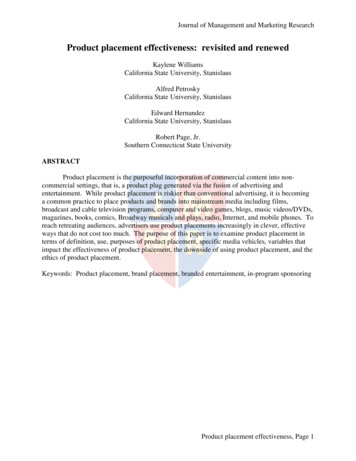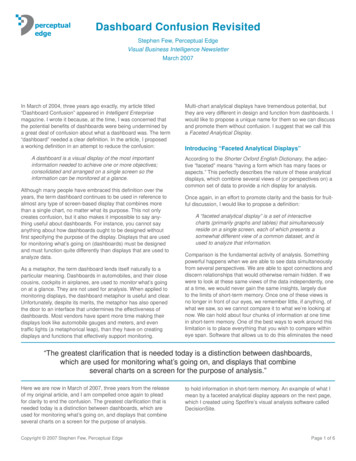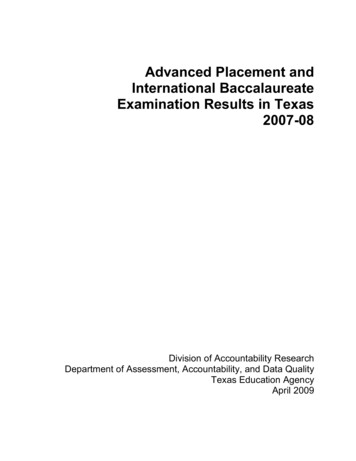
Transcription
Journal of Management and Marketing ResearchProduct placement effectiveness: revisited and renewedKaylene WilliamsCalifornia State University, StanislausAlfred PetroskyCalifornia State University, StanislausEdward HernandezCalifornia State University, StanislausRobert Page, Jr.Southern Connecticut State UniversityABSTRACTProduct placement is the purposeful incorporation of commercial content into noncommercial settings, that is, a product plug generated via the fusion of advertising andentertainment. While product placement is riskier than conventional advertising, it is becominga common practice to place products and brands into mainstream media including films,broadcast and cable television programs, computer and video games, blogs, music videos/DVDs,magazines, books, comics, Broadway musicals and plays, radio, Internet, and mobile phones. Toreach retreating audiences, advertisers use product placements increasingly in clever, effectiveways that do not cost too much. The purpose of this paper is to examine product placement interms of definition, use, purposes of product placement, specific media vehicles, variables thatimpact the effectiveness of product placement, the downside of using product placement, and theethics of product placement.Keywords: Product placement, brand placement, branded entertainment, in-program sponsoringProduct placement effectiveness, Page 1
Journal of Management and Marketing ResearchINTRODUCTIONIn its simplest form, product placement consists of an advertiser or company producingsome engaging content in order to sell something (Falkow, 2010). As such, product or brandplacement continues to be an important practice within advertising and integrated marketingcommunications in which advertisers push their way into content far more aggressively than everbefore (The Economist, 2005). While product placement is riskier than conventional advertising,it is becoming a common practice to place products and brands into mainstream media includingfilms, broadcast and cable television programs, computer and video games, blogs, musicvideos/DVDs, magazines, books, comics, Broadway musicals and plays, radio, Internet, andmobile phones (Stephen and Coote, 2005). Due to media fragmentation, media proliferation, anddeclining advertising efficacy, product placement increasingly is becoming an effective way toreach consumers and non-users (Mackay, Ewing, Newton, and Windisch, 2009). It is estimatedthat two-thirds of TV viewers cut the sound during commercials, channel-surf, or skip themaltogether because they are annoying or irrelevant (Kiley, 2006). Smit, van Reijmersdal, andNeijens (2009) have found that the industry considers brand placement and brand-integratedprograms as the future of television advertising. In recent years, product placement frequentlyhas been used as the basis of multi-million dollar marketing and promotional campaigns withmore than 1000 firms that specialize in product placement (Balasubramanian, Karrh, andPatwardhan, 2006; Argan, Velioglu, and Argan, 2007). The purpose of this paper is to examineproduct placement in terms of definition, use, purposes of product placement, specific mediavehicles, variables that impact the effectiveness of product placement, the downside of usingproduct placement, and the ethics of product placement.PRODUCT PLACEMENT DEFINEDProduct placement is the purposeful incorporation of commercial content into noncommercial settings, that is, a product plug generated via the fusion of advertising andentertainment (Ginosar and Levi-Faur, 2010). Product placement--also known as product brandplacement, in-program sponsoring, branded entertainment, or product integration--is a marketingpractice in advertising and promotion wherein a brand name, product, package, signage, or othertrademark merchandise is inserted into and used contextually in a motion picture, television, orother media vehicle for commercial purposes. In product placement, the involved audience getsexposed to the brands and products during the natural process of the movie, television program,or content vehicle. (Panda, 2004; Cebrzynski, 2006) That is, product placement in popular massmedia provides exposure to potential target consumers and shows brands being used orconsumed in their natural settings (Stephen and Coote, 2005). Ultimately, the product or brandis seen as a quality of the association with characters using and approving of the productplacement, for example, Harold and Kumar on a road trip to find a White Castle, Austin Powersblasting into space in a Big Boy statue rocket, Will Ferrell promoting Checkers and Rally'sHamburgers in the NASCAR comedy Talladega Nights, MSN appearing in Bridget Jones' Diary,BMW and its online short films, Amazon.com's Amazon Theatre showcasing stars and featuredproducts, Ford and Extreme Makeover, Tom Hanks and FedEx and Wilson, Oprah giving awayBuicks, Curious George and Dole, Herbie and VW, Simpsons' and the Quik-E-Mart, ForrestGump and the Bubba Gum Shrimp Co. restaurants, Jack Daniels and Mad Men, and LG phonesin The Office, just to name a few. In addition, Weaver (2007) gives numerous examples ofProduct placement effectiveness, Page 2
Journal of Management and Marketing Researchproduct placements related to tourism, for example, the film Sideways promoting wine tourismin California’s Napa Valley, the Ritz-Carlton hotel chain selling Sealy mattresses on the Internet,Holiday Inn Express selling Kohler’s Stay Smart shower head, Showtime and HBO in manyhotels and motels, and Southwest Airlines serving Nabisco products.Even though product placement was named and identified formally only as recently asthe 1980s, product placement is not new (Balasubramanian, 1994). Originally, productplacement served as a way for movie studios and television networks to reduce the cost ofproduction through borrowed props. Brand/product placement first appeared in Lumiere films inEurope in 1896. (Newell, Salmon, and Chang, 2006) In the early years of U.S. productplacements, the idea of connecting entertainment with consumption messages showed up in theentertainment films of Thomas Edison featuring shots of products from the Edison factory andEdison’s industrial clients. Beginning in the 1930s, Proctor & Gamble broadcasted on the radioits "soap operas" featuring its soap powders. Also, television and film were used by the tobaccocompanies to lend glamour and the "right attitude" to smoking (The Economist, 2005).However, due to poorly organized efforts and negative publicity about the surrender of mediacontent to commercialization, product placements were relatively dormant after the Depression.Product placements were recatalyzed in the 1960-70s with a growth spurt during the 1980s and1990s. (Balasubramanian, Karrh, and Patwardhan, 2006)Movies and programs are watched many times, accordingly, product placements are notlimited in time to the original filmed item. In addition, today's technology can insert productplacements in places they were not before. This digital product integration is a new frontier forpaid product placement. As a result, consumers will see more and more product placements thatare strategically placed in the media. Most product placements are for consumer products, yetservice placements appear more prominently. Service placements tend to be woven into thescript and are probably more effective than product placements that are used simply asbackground props. (La Ferle and Edwards, 2006)Product placements may be initiated by a company that suggests its products to a studioor TV show, or it might work the other way around. Intermediaries and brokers also match upcompanies with product placement opportunities. (Stringer, 2006) Costs for product placementscan range from less than 10,000 to several hundred thousand dollars. However, television andmovie producers routinely place products in their entertainment vehicles for free or in exchangefor promotional tie-ins. (Cebrzynski, 2006)In terms of the Internet, consumers want to communicate with companies and brands sothat they can get the information they want or need. So, companies need to listen to onlineconversations and establish what interests their online community. Then, they can provide thatinformation in an engaging format including storytelling, articles, images, and video. Forexample, Yahoo! has produced branded video content – 5-10 minute “webisodes” that usuallyfeature story lines around a specific product such as a show about someone driving cross countryin a Toyota Hybrid, sponsored by Toyota. (Falkow, 2010) “Being able to creatively brandinteresting and valuable online content that attracts readers and viewers might just turn out to bethe shortest way to consumer’s hearts and minds.” (Falkow, 2010, p. 1)While product placements have been used prolifically to target ultimate householdconsumers, they are beginning to expand into the business-to-business domain. In general,buying-center participants find the practice to be acceptable for a wide array of B2B productsand services. In particular, when buying-center participants are exposed to experimental B2Binfluence through placement within major motion picture products, participants demonstrate anProduct placement effectiveness, Page 3
Journal of Management and Marketing Researchimpressive level of recall and a modestly favorable attitude and purchase intention. (Lord andGupta, 2010)USE OF PRODUCT PLACEMENTEven though measures of its effectiveness have been problematic, product placement is afast growing multi-billion dollar industry (McDonnell and Drennan, 2010). According to theresearch company PQ Media, global paid product placements were valued at 3.07 Billion in2006 with global unpaid product placements valued at about 6 Billion in 2005 and 7.45 Billionin 2006. Global paid product placement spending is expected to grow at a compounded annualrate of 27.9% over 2005-2010 to 7.55 Billion. Consequently, product placement growth isexpected to significantly outpace that of traditional advertising and marketing. By 2010, theoverall value of paid and unpaid product placement is expected to increase 18.4% compoundedannually to 13.96 Billion. (BusinessWire, 2006) Television product placements are thedominant choice of brand marketers, accounting for 71.4% of global spending in 2006 (Schiller,2007). Advertisement spending on product placement in games in the U.S. is likely to reach 1billion by 2010 (Kiley, 2006).The U.S. is the largest and fastest growing paid product placement market, 1.5 Billion in2005, 2.9 Billion in 2007, and 3.7 Billion in 2008 (Brandweek, 2007; Quart, 2008; and BNETBusinessWire, 2008). Marketers increased the dollars spent on branded content in 2009, doublethe 2008 figures. Branded content comprised 32% of overall marketing, advertising, andcommunications budgets. These numbers are expected to jump significantly in 2010. (Falkow,2010) Some 75% of U.S. prime-time network shows use product placements. This number isexpected to increase due to the fact that 41% of U.S. homes are expected to have and use digitalvideo recorders that can skip through commercials. Hence, communicating core marketingmessages is vital and difficult. Consider the following data (1st Place, 2010, p. 1): “90% of people with digital video recorders skip TV ads. “To be seen, brands now have to get inside the content. “Consumer consumption of entertainment increases when economic times get tough. “ITV reported an increase of 1.1% in TV viewing in the first quarter of 2009. “Cinema admissions for 2009 to April 30 stand at 55.2 million, a 14.2% increase onthe same periods in 2008. “Research shows product placement in content boosts brand awareness, raises brandaffinity and encourages prospective purchasers. “60% of viewers felt more positive about brands they recognized in a placement. “45% said they would be more likely to make a purchase.”Product placements can be a cost-effective method for reaching target customers. Because ofthis, product placements are likely to eclipse traditional advertising messages. (Russell andStern, 2006)In terms of specific numbers, U.S. product placement occurrences for January 1 –November 30, 2008 broadcast network programming for the Top 10 programs featured 29,823product placements. Biggest Loser was the leader in terms of the number of product placements(6,248 occurrences, followed by American Idol, Extreme Makeover Home Edition, America’sToughest Jobs, One Tree Hill, Deal or No Deal, America’s Next Top Model, Last ComicStanding, Kitchen Nightmares, and Hells Kitchen. The Top 10 brands that featured productplacements for January 1 – November 30, 2008 were CVS Pharmacy, TRESemme, El PolloProduct placement effectiveness, Page 4
Journal of Management and Marketing ResearchLoco, Bluefly.com, Sears, Glad, Whole Foods Market, Food & Wine Magazine, GQ Magazine,and Hugo Boss. (1st Place,” December 15, 2008)The use of product placements in recorded music also is growing. As noted by Plambeck(2010, p. 1)“According to a report released last week by PQ Media, a research firm, the money spenton product placement in recorded music grew 8 percent in 2009 compared with the yearbefore, while overall paid product placement declined 2.8 percent, to 3.6 billion.“The money is often used to offset the video’s cost, which is usually shared by the artistand label.“Patrick Quinn, chief executive of PQ Media, said that revenue from product placementin music videos totaled 15 million to 20 million last year, more than double the amountin 2000, and he expected that to grow again this year.“The Lady Gaga video, which has been viewed 62 million (updated: 91.8 million as ofNovember 14, 2010) times on YouTube, included product placements from MiracleWhip and Virgin Mobile.”Another area of growing product placements is placed-based video ads in stores,shopping malls, restaurants, medical offices, bars, airports, or health clubs. Approximately29.6% of U.S. adults or 67.4 million adults have viewed these types of video ads in the last 30days. Both young men and young women, in general, are more likely than the population as awhole to report they viewed place-based video ads. Young men aged 18-34 are 28% more likely(young women are 13% more likely) than the population as a whole to have viewed a placebased video ad in the last 30 days. This is important because these young consumers are difficultto reach via traditional media. “Video advertising in stores and shopping malls garnered thelargest audience, at nearly 19% and 15% of the U.S. adult population, respectively. This wasfollowed by nearly 11% of U.S. adults who saw a video ad in the last 30 days in a restaurant ormedical office, nearly 9% who saw a video ad in a bar/pub or at an airport, and 7% who saw avideo ad while at the gym or health club.” (gfkmri.com, 2010, p. 1)Generally, U.S. product placement markets are much more advanced than other countriessuch that other countries often aspire to the U.S. model. The next largest global markets areBrazil, Australia, France, and Japan. China is forecast to be the fastest growing market forproduct placements this year, up 34.5% (Thomasch, 2007). Product placement methods differwidely by country given varying cultures and regulations. Most product placements are in fiveproduct areas: transportation and parts, apparel and accessories, food and beverage, travel andleisure, and media and entertainment. (BusinessWire, 2006)PURPOSES OF PRODUCT PLACEMENTProduct placement can be very useful. Ultimately, product placements amongentertainment firms, corporate brands, and agencies are all monetarily driven, either directly orindirectly. At the very least, entertainment firms and independent production companies arehoping to reduce their budgets so that more dollars can be invested elsewhere. (Chang, Newell,and Salmon, 2009) Its purposes include achieving prominent audience exposure, visibility,attention, and interest; increasing brand awareness; increasing consumer memory and recall;creating instant recognition in the media vehicle and at the point of purchase; changingconsumers' attitudes or overall evaluations of the brand; changing the audiences' purchasebehaviors and intent; creating favorable practitioners' views on brand placement; and promotingProduct placement effectiveness, Page 5
Journal of Management and Marketing Researchconsumers' attitudes towards the practice of brand placement and the various product placementvehicles. (Panda, 2004; Kureshi and Sood, 2010) As noted by van Reijmersdal, Neijens, andSmit (2009), a substantial part of the effects and interactions of product placement is stillunknown.(1) To achieve prominent audience exposure, visibility, attention, and interestProduct placements can have a significant effect on message receptivity (Panda, 2004).The sponsor of product placements is likely to gain goodwill by associating itself with a popularprogram targeted to a specific audience. The more successful the program, the longer shelf lifeof the product placement. (Daugherty and Gangadharbatla, 2005; d'Astous and Seguin, 1999)Interest in advertising appearing in product placement in movies is reported to be of“considerable” or “some” interest to 31.2% of consumers (NextMedium, 2008). More frequentviewers and viewers who enjoy the program pay more attention to product placements. Brandsneed to be visible just long enough to attract attention, but not too long to annoy the audience.(Argan, Velioglu, and Argan, 2007)(2) To increase brand awarenessNielsen Media Research has shown that product placement in television shows can raisebrand awareness by 20% (Cebrzynski, 2006). Tsai, Liang, and Liu (2007) found that higherbrand awareness results in a greater recall rate, more positive attitudes, and a stronger intentionof buying. When brand awareness is high, a positive attitude toward the script leads to a higherrecall rate. Also, when a brand gains a certain level of awareness, the more positive the attitudetoward product placement, the stronger its effect on recall rate, attitude, and intention of buying.However, when product/brand awareness is not high enough, consumers typically fail even toremember the names of the advertised products.(3) To increase consumer memory and recall of the brand or productProduct placements can have a significant effect on recall (Panda, 2004). For example,memory improves when visual/auditory modality and plot connection are congruent (Russell,2002). Pokrywczynski (2005) has found that viewers can correctly recognize and recall placedbrands in movies, using aided recall measures and free recall measures. Also, brands placedprominently in a movie scene enjoy higher brand recall than those that are not. Verbal and visualbrand placements are better recalled than placements having one or the other. In addition,showing the brand early and often with at least one verbal mention enhances brand recall(Romaniuk, 2009). Also, sitcoms rather than reality shows tend to spark better recall for productplacements (McClellan, 2003). Hong, Wang, and de los Santos, (2008) found that productplacement upholds brand salience or the order in which brands come to mind. They note that tobuild brand salience, product placement strategies should focus on how a product can explicitlyconvey the product’s superiority, durability, performance, and specification. That is, marketersshould focus on how a product can be noticed, even if it is perceived as artificially inserted forcommercial purpose. As such, marketers need to give as much attention to product placementsas they do to the insertion of commercials into a television program. To achieve higher brandsalience, they also found that products should be placed more in negative-context programmingProduct placement effectiveness, Page 6
Journal of Management and Marketing Researchthan in positive ones and should not excessively interfere with the plot. In addition, Gupta andGould (2007) found that greater recall can be obtained by smart placement of product placementsin game shows, in particular, placements that appear at the beginning of a game show commandhigher recall. Brand recall is typically no higher than 30% (Pokrywczynski, 2005). Or, assummarized by van Reijmersdal (2009, p. 152), “Prominent brand placement affects memorypositively, but affects attitudes negatively when audiences are involved with the medium vehicle,when they like the medium vehicle, or when they become aware of the deliberate brandplacement (selling attempt).”(4) To create instant recognition of the product/brand in the media vehicle and at the pointof purchaseProduct placement can have a significant effect on recognition (Panda, 2004). Familiarbrands achieve higher levels of recognition than unfamiliar brands (Brennan and Babin, 2004).In addition, product or brand placement recognition levels received from audio-visual prominentplacements exceed the recognition rates achieved by visual-only prominent placements (Brennanand Babin, 2004). Some 57.5% of viewers recognized a brand in a placement when the brandalso was advertised during the show. That number is higher than the 46.6% of viewers whorecognized the brand from watching only a television spot for the brand. (Cebrzynski, 2006)While prominence of the placement leads to increased recognition, if the placement is too long ortoo prominently placed, viewers might become suspicious, elaborate on the commercial purposeof the placement, counter-argue, and form negative attitudes or behaviors. (Van Reijmersdal,Smit, and Neijens, 2010) In addition, star liking, cognitive effect, and pleasure affect recognitionfor product placements. (Scott and Craig-Lees, 2010) Specifically, brand recognition due toproduct placements increased 29% during highly enjoyable programs (NextMedium, 2008).(5) To bring desired change in consumers' attitudes or overall evaluations of the brandThe influence of product placement on attitudes, preferences, and emotions toward aproduct or brand has not been researched very much. With this in mind, however, no differenceshave been found in viewers' attitudes toward a product or brand. On the other hand, initialevidence suggests that consumers align their attitudes toward products with the characters'attitudes to the products. In addition, this process is driven by the consumers' attachment to thecharacters. (Pokrywczynski, 2005; Russell and Stern, 2006) Argan, Velioglu, and Argan (2007)suggest that the audience pays attention to and accepts brand placement in movies and takescelebrities as references when shopping. However, the movie should not be overcommercialized. At the same time, initial studies find that attitudes toward product placementsdo not differ based on gender, age, income, or education. However, as discussed later, morerecent studies have found differences. Authors van Reijmersdal, Neijens, and Smit (2007) havefound that as consumers watch more episodes, the brand image becomes more in agreement withthe program image. This confirms that learning and human association memory are important tobrand placement. It also has been noted that product placements on emotionally engagingprograms were recognized by 43% more viewers (NextMedium, 2008)Product placement effectiveness, Page 7
Journal of Management and Marketing Research(6) To bring a change in the audiences' purchase behaviors and intentProduct placements are associated with increased purchase intent and sales, particularlywhen products appear in sitcoms, for example, Ally McBeal in Nick and Nora pajamas, Frasierand Friends in Starbucks and New World Coffee, and Cosmopolitan martinis in Sex and the City(Russell and Stern, 2006; Panda, 2004). In one example, Dairy Queen was featured on TheApprentice. The contestants needed to create a promotional campaign for the Blizzard. Duringthe week of the broadcast, Blizzard sales were up more than 30%. Website hits also were upsignificantly on the corporate and Blizzard Fan Club sites as well as the Blizzard promotionalsite. While DQ had six minutes of screen time, the overall tone was a little harsh with twocontestants arguing. So, it was not the most positive environment for good, old-fashioned DQ.However, it cost DQ in the "low seven figures" to appear on the show and run its supportingpromotion. Not bad for a 30% increase in sales. (Cebrzynski, 2006) Controversy does seem togenerate attention.(7) To create favorable practitioners' views on brand placementPractitioners' views on product placement generally are favorable or else the productplacement market would not continue to increase. Practitioners remain positive about productplacements as long as no harm is done, sales and brand image go up, and consumers are positiveabout the product and brand. Also, product placements help the practitioner make up for anincreasingly fragmented broadcast market due to technology such as TiVo and DVD recorders.(8) To promote consumers' attitudes towards the practice of brand placement and thevarious product placement vehiclesIn general, attitudes toward product placement are favorable across media types.Additionally, viewers tend to like product placements as long as they add realism to the scene.Snoody (2006) has found that viewer enjoyment of product placements actually increased formedia vehicle versions of product placements where products were an integral part of the script.He conjectures that peoples' lives are so saturated with brands that the inclusion of identifiableproducts adds to the sense of reality, that is, validates the individual's reality. Also, productplacements are preferred to fictitious brands and are understood to be necessary for costcontainment in the making of programs and movies (Pokrywczynski, 2005). About half ofrespondents said that they would be more likely to buy featured products. People with morefashionable and extroverted lifestyles typically have more positive attitudes toward productplacement (Tsai, Liang, and Liu, 2007). Sung and de Gregorio (2008) found that collegestudents’ attitudes toward brand placement are positive overall across media, but that brandplacements in songs and video games are less acceptable than within films and televisionprograms. So, marketers need to take into account the appropriateness of the specific genre ofthe particular media program into which they intend to place brands. Non-students are moreneutral toward the practice than students. In general, consumers are positively disposed towardproduct placement, value the realism of the ad, and do not consider the ad to be unethical ormisleading as long as the product is not ethically charged, for example, alcohol. (Sung, deGregorio, and Jung, 2009) Also, while there is a generally positive perception of the practiceoverall, there are reservations regarding the insertion of certain ethically charged products suchProduct placement effectiveness, Page 8
Journal of Management and Marketing Researchas firearms, tobacco, and alcohol (de Gregorio and Sung, 2010). (Sung and de Gregorio, 2008)Also, if brand image is positive, then consumers' brand evaluations toward the product placementseem to be more positive (Panda, 2004). Older consumers are more likely to dislike productplacements and more likely to consider the practice as manipulation (Nelson and McLeod,2005). (Daugherty and Gangadharbatla, 2005)Overall, the managerial implications have been stated eloquently and succinctly by vanReijmersdal, Neijens, and Smit (2010, p. 441):“To create brand placements that are positively evaluated, they should be placed withinprograms, movies, games, or magazines that are involving for the audience. Placementsare also positively evaluated when the placement format is more editorial rather thancommercial.“To increase brand memory, brands should be prominently placed and be accompaniedby an actor in films or television programs. Brand evaluations can become more positivewhen the placement is more editorial instead of commercial and when non-users of thebrand are reached. Behavior and behavioral intentions are influenced best when theaudience has positive evaluations of brand placement, when placements are presented ineditorial formats, and when placements are repeated.”USE OF PRODUCT PLACEMENT IN SPECIFIC MEDIAResearchers have studied product placement in various media: advergames,computer/video games, digital games, movies, television, television magazines (Matthes,Schemer, and Wirth, 2007), novels (Brennan, 2008), online games, simulation games, sportingevents, game shows (Gupta and Gould, 2007), radio, physical environments such as hotel rooms,rental cars, or ships (Weaver, 2007), virtual/online environments (Yaveroglu and Donthu, 2008),and songs (Delattre and Colovic, 2009). Most product placement studies have focused on film(33.87%), television (32.25%), and video games (20.21%). (Kureshi and Sood, 2010) Inactuality, most product placement is done through television, film, and video games. However,regardless of the media used, the brand's image and the content vehicle need to fit in such a waythat the product/brand image will not be harmed and that attention will be brought to the productor brand (Cebrzynski, 2006). Also, because advertisers continue to look for ways to stay intouch with consumers, they easily could follow their audiences into less-regulated media such asthe Internet and 3-G mobile phones. As web-connected television becomes a practical reality, auser-driven environment and peer-to-peer file swapping is being reinforced. While newplatforms such as 4G and MPEG-4 create greater opportunities for interactivity, successfulproduct placement still must be relevant to its host content. (New Media Age, August 11, 2005)TelevisionTelevision viewing is complicated with the use of zipping, zapping, TiVo, and DVRs.That is, the audience can shift the channel, change the program, and slow down or fast-forwardthe program to
Hamburgers in the NASCAR comedy Talladega Nights, MSN appearing in Bridget Jones' Diary, . Ford and Extreme Makeover, Tom Hanks and FedEx and Wilson, Oprah giving away Buicks, Curious George and Dole, Herbie and VW, Simpsons' and the Quik-E-Mart, Forrest Gump and the Bubba Gum Shrimp Co. restaurants, Jack Daniels and Mad Men, and LG phones










